#tianyuraptor
Text
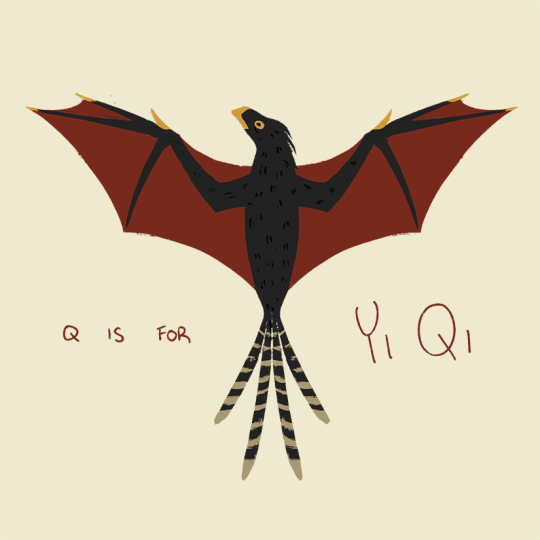



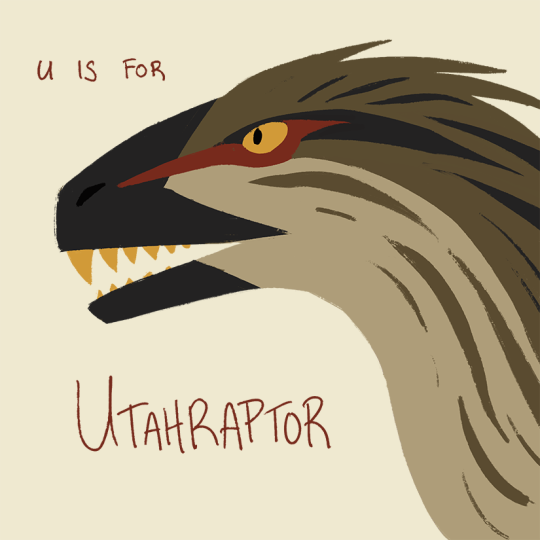
The Maniraptoran Alphabet (Part 4)
Part 4 of my dinosaur alphabet! I'll admit Yi qi for Q is the most questionable of the letters, given that it's the only one picked for species name rather than genus name. Unfortunately, though, the only genera I could find that fit my requirements (maniraptorans extinct before the Eocene) were things described in only 1 or 2 papers and had no pre-existing restorations to reference, so I would've had to make restorations for them whole cloth, and I just didn't have the time for that on this project (though maybe I will some other time?). So Yi qi was moved from Y to Q and I picked a different species for Y. (The other thing I was considering was throwing Quetzalcoatlus in there as a curveball, since it's not even a dinosaur muchtheless a maniraptoran, but that probably would have been a joke only for me.)
#dinosaur#maniraptoran#alphabet#scansoriopterygid#dromaeosaurid#yi qi#rahonavis#sinornithosaurus#tianyuraptor#utahraptor#illustration#paleoart#artaneae
141 notes
·
View notes
Text

Tianyuraptor!
Just a little fella. This one is just a fairly quick design.
details under cut.


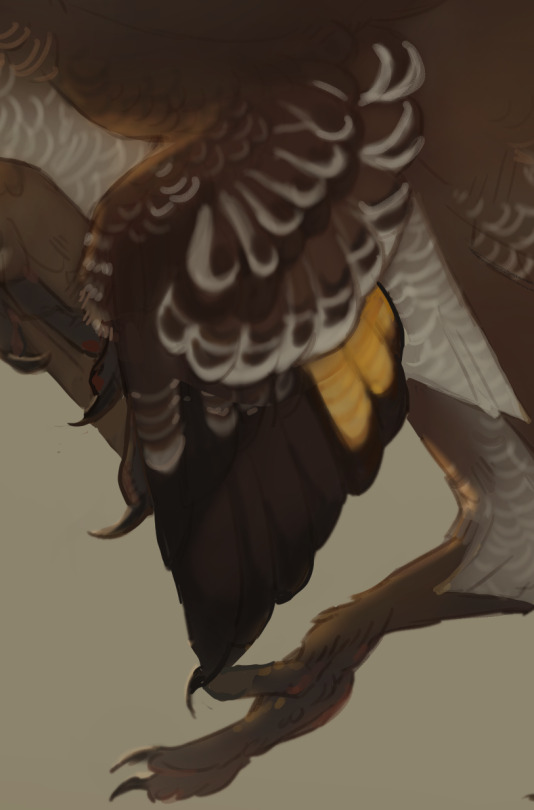
202 notes
·
View notes
Note
Would any dromaeosaurs have likely had bald heads like turkey vultures?
It's certainly possible, and I'd go so far as to say quite likely!
We do have some fossil evidence for dromaeosaurs with feathered heads:
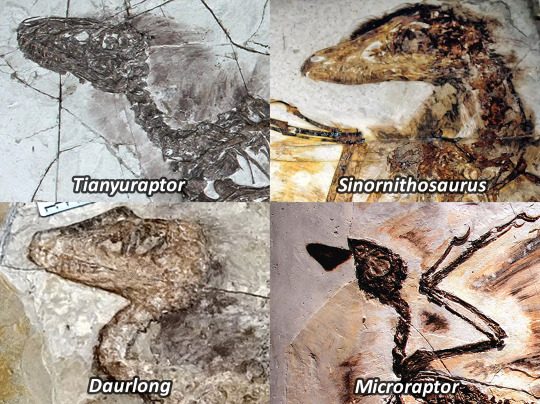
Image sources: Tianyuraptor, Sinornithosaurus, Daurlong, Microraptor.
As for the rest though, we don't have a clear fossil of a bald-headed dromaeosaur! To be certain, we'd probably need to find specific impressions of naked skin around the head, which to my knowledge has not been found yet.
The feathered fossils above belong to either small (right side) or medium-sized (left side) dromaeosaurs, so it indicates that any dromaeosaurs up to a Velociraptor-type size certainly could have had feathered heads.
That being said, the level of head feathering is very variable in modern birds even within the same group. Some vultures have bald heads which may help with cleaning their faces and heat regulation, but there's much wider variation than you might expect! Even just within the clade Aegypiinae, we've got:
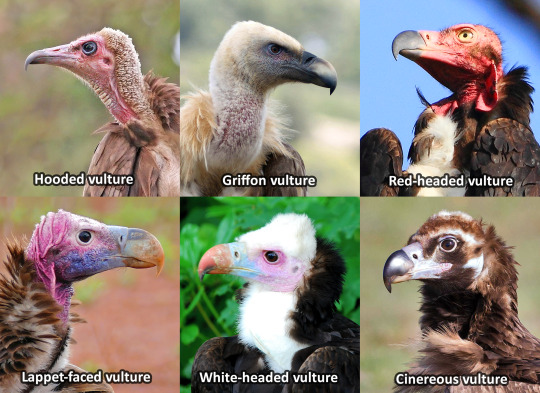
Image sources: hooded, griffon, red-headed, lappet-faced, white-headed, cinereous.
There's a whole range from nearly full plumage to fully naked skin folds to Justin Timberlake Ramen Hair, and I'd say there's no reason to think that dromaeosaurs and other feathered dinosaurs couldn't have had the same level of variation between species!
It's the kinda situation where in the absence of direct evidence, I'd consider varying levels of head baldness in dromaeosaurs as pretty reasonable speculation! So here's a Deinonychus decked out with a variety of different styles that are within the realms of possibility:
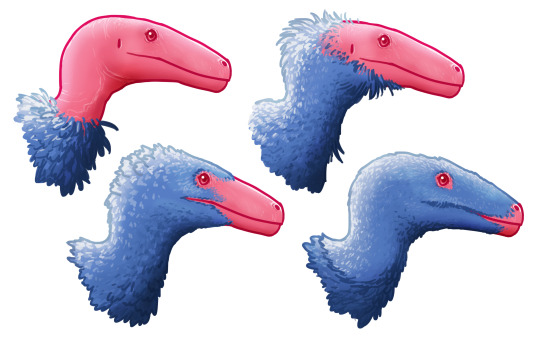
And that's not even taking into account that in a lot of bald-headed birds that skin space is prime real estate for all sorts of flippy flappy dangly bits and colours and lumps and bumps.
So basically, it's not like we can point at any particular dromaeosaurs and be like "that one probably had a bald head", but unless there's contrary evidence I feel it's very likely there was a lot of variation in how feathery the head was!
766 notes
·
View notes
Text
Daurlong wangi Wang et al., 2022 (new genus and species)
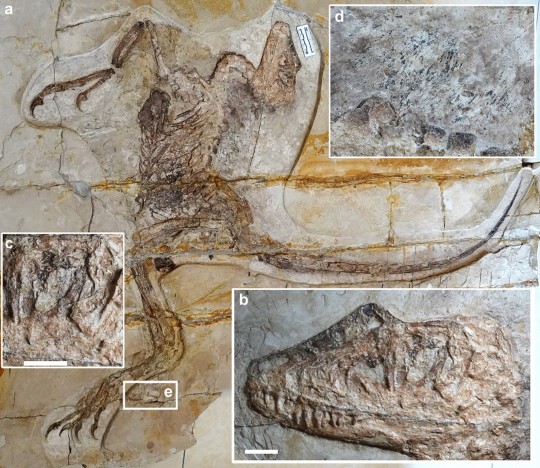
(Type specimen of Daurlong wangi [b: close-up of skull; c: close-up of eye socket; d: close-up of preserved feathers; e: frog skeleton preserved nearby; scale bars = 20 mm for b and 10 mm for c], from Wang et al., 2022)
Meaning of name: Daurlong = Daur dragon [in Chinese]; wangi = for Wang Junyou [director of the Inner Mongolia Museum of Natural History]
Age: Early Cretaceous (Aptian), about 121 million years ago
Where found: Longjiang Formation, Inner Mongolia, China
How much is known: Nearly complete skeleton of one individual with preserved feathers.
Notes: Daurlong was a dromaeosaurid theropod, making it a fairly close relative to Velociraptor and Deinonychus. It was especially similar to Tianyuraptor and Zhenyuanlong of the Jehol Biota (also from the Early Cretaceous of China). Like Tianyuraptor and Zhenyuanlong, it had relatively short forelimbs for its size, and was larger than most other Early Cretaceous dromaeosaurids that have been found in China, being about 1.5 m long in total length.
The type specimen of Daurlong not only preserves an exceptionally complete skeleton with feather remains, but also a dark mass in its abdominal cavity. In terms of shape and anatomical position, this mass resembles the preserved intestines of Scipionyx, a theropod known from a well-preserved juvenile specimen from the Early Cretaceous of Italy, and may therefore also represent preserved intestinal remnants in Daurlong.
Reference: Wang, X., A. Cau, B. Guo, F. Ma, G. Qing, and Y. Liu. 2022. Intestinal preservation in a birdlike dinosaur supports conservatism in digestive canal evolution among theropods. Scientific Reports 12: 19965. doi: 10.1038/s41598-022-24602-x
273 notes
·
View notes
Text

Also from Cretaceous China, Zhenyuanlong suni is unique in that its fossil provided the first evidence of pennaceous (veined) feathers in large, non-flying dromaeosaurs. Zhenyuanlong was over 122.6 centimetres (4.02 ft) long… but half of its tail is broken off. When compared to its close relative Tianyuraptor, it can be estimated to have been around 165 centimetres (5.41 ft) long in life, and with the addition of tail feathers could have been up to 2 metres (6.6 ft) long! There is only one fossil of Zhenyuanlong, and it is a subadult, so the animal could have been even larger in adulthood. This puts it at about the midway point between Velociraptor and Deinonychus, about the size of a modern condor.
Zhenyuanlong had very short arms, but (comparatively) very large, broad wings, as well as long, wide feathers on its tail. However, due to its body size, it’s unlikely the animal could have flown or even glided. This raises the question of what such a large dromaeosaur was doing with such complex wings. They could have been remnants of a flying ancestor, and retained for sexual display. They could have also been used for aerodynamics, as Zhenyuanlong had very long legs and was likely a pursuit predator, the wings would have assisted in balance. Zhenyuanlong also lacked the veined leg-feathers of its Microraptorian relatives, freeing its legs up for quicker speeds.
#my art#SaritaDrawsPalaeo#Zhenyuanlong suni#Zhenyuanlong#dromaeosaur#raptor#theropods#dinosaurs#archosaurs
212 notes
·
View notes
Text
Changyuraptor yangi

By Scott Reid
Etymology: Long Feathered Robber
First Described By: Han et al., 2014
Classification: Dinosauromorpha, Dinosauriformes, Dracohors, Dinosauria, Saurischia, Eusaurischia, Theropoda, Neotheropoda, Averostra, Tetanurae, Orionides, Avetheropoda, Coelurosauria, Tyrannoraptora, Maniraptoromorpha, Maniraptoriformes, Maniraptora, Pennaraptora, Paraves, Eumaniraptora, Dromaeosauridae, Microraptoria
Status: Extinct
Time and Place: About 124.4 million years ago, in the Aptian of the Early Cretaceous


Changyuraptor is known from the Dawangzhangzi Bed of the Yixian Formation

Physical Description: Changyuraptor was a medium sized dinosaur, about 1.2 meters long - something like a modern turkey in terms of weight. It was covered from head to toe in feathers, including full wings on its arms, a large tail fan, and wings on its legs. It had a small, pointy head and long tail, while its body was fairly stocky. It also had sharp claws on its hands and sickle claws on its feet, like other raptor-dinosaurs. It’s tail was so long and feathered - with feathers reaching up to 30 centimeters in length and being the largest feathers known in a non-avian dinosaur - it would have allowed for softer landings for Changyuraptor. In short, it was probably the largest and fluffiest four-winged dinosaur known.
Diet: Changyuraptor would have primarily fed upon small animals like mammals, lizards, and amphibians.
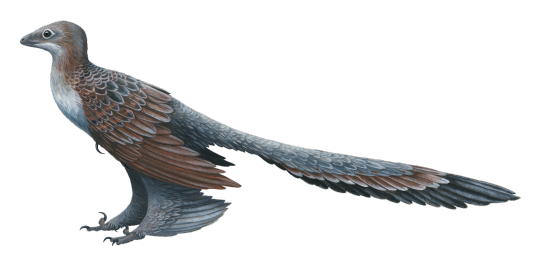
By Emily Willoughby, CC BY-SA 4.0
Behavior: Like Microraptor, Changyuraptor was probably capable of flight, making it one of the largest flying dinosaurs of the Mesozoic Era - with very few birds ever growing larger than it. It wouldn’t have been a particularly good flier though, only about as well as a chicken, taking off clumsily from the ground to go from area to area. It didn’t have enough strength in the chest and wing muscles to do much more than this, though it’s possible the hindlimb feathers would have allowed for some maneuvering in the air. It then could pounce on its prey, using its sickle claw to hold onto struggling animals before eating them.
More importantly; the wings, tail fan, and leg wings would have all been good display structures for Changyuraptor, which would have used them to communicate with other members of the species. These feathers would have signaled anger, a desire to mate, or danger, as feathers today are used by birds. It’s probable, then, that at least some fancy coloration may have been present on Changyuraptor to aid in the communication. Changyuraptor would have been a very active animal and most likely would have taken care of its young. In fact, it may have used its variety of wings and fans to help brood the nest.
Ecosystem: Changyuraptor lived in the Yixian Formation, a highly diverse ecosystem showcasing the evolution of birdie dinosaurs - like Changyuraptor - at the beginning of the Cretaceous period. A temperate, seasonal, and humid climate, it was much like the modern day northwestern Pacific Coast, though it would have seen snow on a regular basis, as well as notable dry seasons. It was a diverse coniferous forest, with a variety of flowering plants, ferns, horsetails, ginkgoes, cycads, seed ferns, and many others. Changyuraptor would have probably spent most of its time in the trees as well as on the ground, given its flight ability. There were a lot of freshwater lakes, and abundant volcanic eruptions.
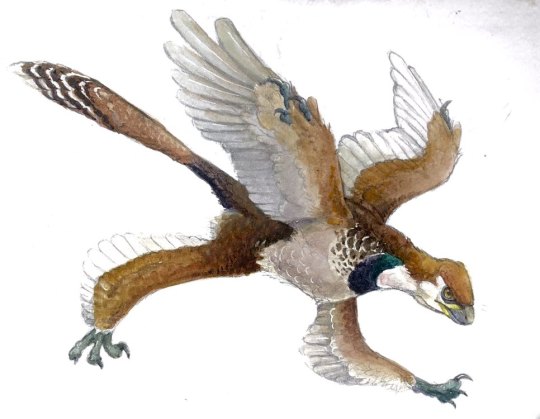
By Ripley Cook
Changyuraptor lived along so many other kinds of dinosaurs, it’s almost impossible to list them all. There were ankylosaurs like Liaoningosaurus and ornithopods like Bolong and Jinzhousaurus. There was the larger Compsognathid Sinosauropteryx, as well as many raptors in addition to Changyuraptor like the large Zhenyuanlong, Sinornithosaurus, and Tianyuraptor. There was also the Troodontid Jianianhualong, the seed eating protobird Jeholornis, smaller protobirds like Confuciusornis and Zhongornis, and the Anchiornithid Yixianosaurus. Opposite birds were there too like Dalingheornis and Shanweiniao, as well as near-birds like Archaeorhynchus, Eogranivora, Yanornis, Hongshanornis, and Longicrusavis. Non-dinosaurs like fish, amphibians, and lizards were also there; they along with mammals like Akidolestes, Sinobaatar, Sinodelphys, Chaoyangodens, and Eomaia would have been the primary prey of Changyuraptor. There were also Choristoderes like Hyphalosaurus and Monjurosuchus, as well as pterosaurs like Cathayopterus and Ningchengopterus. In short, a fascinating snapshot of Early Cretaceous life.
Other: Changyuraptor was closely related to - and preceded - Microraptor, one of the best known feathered dinosaurs; though we don’t know if it would have been colored like Microraptor, it’s possible it may have also had iridescent feathers like its later relative.
~ By Meig Dickson
Sources under the Cut
Amiot, R., X. Wang, Z. Zhou, X. X. Wang, E. Buffetaut, C. Lécuyer, Z. Ding, F. Fluteau, T. Hibino, N. Kusuhashi, J. Mo, V. Suteethorn, Y. Y. Wang, X. Xu, F. Zhang. 2011. Oxygen isotopes of East Asian dinosaurs reveal exceptionally cold Early Cretaceous climates. Proceedings of the National Academy of Sciences 108 (13): 5179 - 5183.
Benson, R.B.J. & Brussatte, S. (2012). Prehistoric Life. London: Dorling Kindersley. p. 332.
Choi, Charles (15 July 2014). "Bizarre Dinosaur Had 4 'Wings,' Long Tail Feathers". LiveScience.com. Retrieved 16 July 2014.
Gang Han; Luis M. Chiappe; Shu-An Ji; Michael Habib; Alan H. Turner; Anusuya Chinsamy; Xueling Liu & Lizhuo Han (15 July 2014). "A new raptorial dinosaur with exceptionally long feathering provides insights into dromaeosaurid flight performance". Nature Communications. 5: 4382.
Iacurci, Jenna (15 July 2014). "New Four-Winged Dinosaur Built for Flight". Nature World News. Retrieved 16 July 2014.
Larsson, Hans, Hone, David, Dececchi, T. Alexander, Sullivan, Corwin, Xu, Xing. "THE WINGED NON-AVIAN DINOSAUR MICRORAPTOR FED ON MAMMALS: IMPLICATIONS FOR THE JEHOL BIOTA ECOSYSTEM" "Program and Abstracts. 70th Anniversary Meeting Society of Vertebrate Paleontology October 2010" 114A.
Meng, F.X.; Gao, S.; Liu, X.M. (2008). “U-Pb zircon geochronology and geochemistry of volcanic rocks of the Yixian Formation in the Lingyuan area, western Liaoning, China”. Geological Bulletin of China. 27: 364–373.
Morgan, James (16 July 2014). "Four-winged dinosaur is 'biggest ever'". BBC News. Retrieved 16 July 2014.
Naish, Darren (2012). Planet Dinosaur: The Next Generation of Killer Dinosaurs. Firefly Books. p. 186.
Nicholas R. Longrich; David M. Martill; Brian Andres (2018). "Late Maastrichtian pterosaurs from North Africa and mass extinction of Pterosauria at the Cretaceous-Paleogene boundary". PLOS Biology. 16 (3): e2001663.
Pickrell, John (16 July 2014). "Four-winged dinosaur had record-breaking tail feathers". Australian Geographic Society. Retrieved 16 July 2014.
Wang, Y., S. Zheng, X. Yang, W. Zhang, Q. Ni. 2006. The biodiversity and palaeoclimate of confier floras from the Early Cretaceous deposits in western Liaoning, northeast China. International Symposium on Cretaceous Major Geological Events and Earth System: 56A.
Zhou, Z. 2006. Evolutionary radiation of the Jehol Biota: chronological and ecological perspectives. Geological Journal 41: 377-393.
#Changyuraptor#Changyuraptor yangi#Dromaeosaur#Raptor#Dinosaur#Bird#Birds#Dinosaurs#Feathered Dinosaurs#Paleontology#Prehistoric Life#Prehistory#Birblr#Palaeoblr#Factfile#Carnivore#Eurasia#Theropod Thursday#Cretaceous
263 notes
·
View notes
Note
Did Velociraptor have legwings like Microraptor?
The feathers of Velociraptor have not been preserved, so we don’t know for sure. The only Velociraptor-sized dromaeosaurid for which we have direct preservation of feathers is Zhenyuanlong, which does not show any trace of hind wings. The describers of Zhenyuanlong do acknowledge that it’s possible the hind wings simply weren’t preserved, but an undescribed specimen of Tianyuraptor (presented at last year’s SVP and considered to be the same as Zhenyuanlong by the presenters) doesn’t display hind wings either, despite also being preserved with feathers elsewhere. If I had to guess based on the very limited evidence that we have, I suspect Velociraptor did not have hind wings (at least not the very well-developed ones found in Microraptor).
5 notes
·
View notes
Note
Hi!! I was wondering if you have a list, or know of some interesting or unique raptors? I really REALLY love them, and I want to learn more about their genus and evolutionary branch!
I like raptors a lot, too! They’re some of my favorite dinosaurs.
A decent place to start for a list is the #raptor tag over at @a-dinosaur-a-day. There’s also Wikipedia – both the dromaeosaurid page and the timeline of research have some fairly up-to-date information.
But here’s a few I think are particularly interesting:
The unenlagiine subgroup had very long snouts and slender limbs, and may have been wading fish-eaters like modern herons. They include some of the smallest known raptors like Buitreraptor, and also one of the largest, Austroraptor.
The microraptorians include the “four-winged” gliders like Microraptor. We also know about the feather colors of some of them – Microraptor itself was a glossy iridescent black, while Sinornithosaurus was a mixture of reddish-brown, yellow, black and grey.
Mahakala, Tianyuraptor and Zhenyuanlong had unusually tiny arms, and the latter also preserves long wing and tail feathers.
The famous Velociraptor had quill knobs on its arm bones, evidence of large feathers. It was probably nocturnal, and while it occasionally got into fights with Protoceratops it also sometimes scavenged from carcasses. Despite how stiffly its tail is normally depicted, one specimen suggests that it might have actually had some degree of flexibility in life.
Fossilized eggshells have been found associated with a specimen of Deinonychus, in a position that suggests it may have been brooding on a nest when it died. It was also the main subject of a study on the uses of raptors’ distinctive sickle claws – they were probably used for holding down small prey while eating it alive.
Utahraptor was possibly the largest known raptor at over 6m long, and also had some weird body proportions compared to its close relatives – a bulky body, short tail, stocky limbs, and an oddly curved lower jaw. A big slab containing at least six skeletons is currently being excavated and studied (supported by crowdfunding!), so more discoveries are still waiting to be made.
Another large raptor, Dakotaraptor, had quill knobs similar to those seen in Velociraptor, showing that even the “giant” raptors still had well-developed feathers. Two different adult body shapes are seen in its fossils, which might be evidence of sexual dimorphism.
149 notes
·
View notes
Text

Zhongjianosaurus yangi, the Four-winged Stilt Raptor: If you thought Zhenyuanlong had long legs, get a load of these gams!
Zhongjianosaurus was another Microraptorian from… you guessed it, Cretaceous China. It was one of, if not the, smallest dromaeosaurs, about the size of a roadrunner.
The large amount of dromaeosaurs and troodontids in the Yixian Formation suggests there was a significant amount of niche partitioning, so that each raptor had a particular niche they were adapted for. While Tianyuraptor, Zhenyuanlong, and Changyuraptor would have hunted larger prey (and perhaps also smaller dromaeosaurs), the smaller Microraptorians like Zhongjianosaurus would have hunted various other prey, such as birds, small mammals, lizards, insects, or even fish.
Zhongjianosaurus itself was possibly omnivorous and ground-dwelling, keeping to the safety of the underbrush and looking out for larger dinosaurs.
#my art#SaritaDrawsPalaeo#Zhongjianosaurus#Zhongjianosaurus yangi#dromaeosaur#raptor#theropods#saurischians#dinosaurs#archosaurs
33 notes
·
View notes
Text

Archovember Day 19: Sinosauropteryx prima
In life, Sinosauropteryx would have been just like any other compsognathid. But it is very important to paleontology for a variety of reasons.
For one, it was the first non-avialan (bird-winged) dinosaur to be discovered with evidence of feathers. Not only that, but these feathers were so well-fossilized, that we could determine the structure and placement of their melanosomes, and thus what colors and patterns the dinosaur would have been! Thus, Sinosauropteryx was the first non-avialan dinosaur whose life appearance we can be almost certain of! We know that it was covered almost completely in soft, down-like feathers, had a long striped tail, was countershaded with reddish-brown feathers on top and white on the bottom, and had a raccoon-like band across its eyes.
Sinosauropteryx lived in Early Cretaceous China. It was only around 3 feet long, about the size of a small cat. It was smaller than the European Compsognathus, but had a very long tail, the longest (in proportion to its body) of any theropod! One specimen was preserved with a lizard in its gut, and another with mammal jaws, indicating it would have chased down small, fast-moving animals. Aside from its prey, it would have lived alongside various small birds, the therizinosaur Beipiaosaurus, the bipedal ceratopsian Psittacosaurus, the microraptorine Sinornithosaurus, the troodontid Mei, the dromeosaur Tianyuraptor, the much larger compsognathid Sinocalliopteryx, the sauropod Dongbeititan, and the tyrannosauroids Dilong and Yutyrannus.
#my art#Sinosauropteryx#Sinosauropteryx prima#compsognathids#theropods#saurischians#dinosaurs#archosaurs#archosauromorphs#Archovember#Archovember 2021#Draw Dinovember#Draw Dinovember 2021#Dinovember#Dinovember 2021#SaritaDrawsPalaeo
85 notes
·
View notes
Text
Jinzhousaurus yangi

By José Carlos Cortés
Etymology: Reptile from Jinzhou
First Described By: Wang & Xu, 2001
Classification: Dinosauromorpha, Dinosauriformes, Dracohors, Dinosauria, Ornithischia, Genasauria, Neornithischia, Cerapoda, Ornithopoda, Iguanodontia, Dryomorpha, Ankylopollexia, Styracosterna, Hadrosauriformes, Hadrosauroidea
Status: Extinct
Time and Place: Jinzhousaurus lived about 124.4 million years ago, in the Aptian of the Early Cretaceous


Jinzhousaurus is known from the Dawangzhangzi Beds of the Yixian Formation

Physical Description: Jinzhousaurus was a Hadrosauroid, a type of dinosaur closely related to the duck-billed dinosaurs (Hadrosaurids) of the late Cretaceous - and a member of the group from which they evolved. This group experimented a lot with how they chewed and acquired food, mainly in order to deal with the rapidly changing environment of the Cretaceous Period. As the late Cretaceous turned into a very humid landscape, however, most of these forms died out, giving way to the Hadrosaurids to take over with their specialized-for-mushy-plant-food mouths. Jinzhousaurus was a fairly medium-sized dinosaur, reaching about 7 meters in length with a skull a half a meter long. It had very large nose holes and a wide back of the skull, with a small crest. It probably would have moved back and forth between walking on two legs versus four. It had three toes on each foot and five fingers on each hand, though only the first three fingers had claws - so it wasn’t really evolving the hoof-like front limbs seen in the Hadrosaurids proper. Its snout wasn’t a duckbill, but more like that of Iguanodon, with a rounded bulky beak - but different enough that it probably had a different feeding strategy than its cousin. Its back was stiffened extensively, making it rigid for balance and the tail mainly inflexible.
Diet: Jinzhousaurus primarily ate plants at the medium-browsing level - so mainly coniferous trees and the like.
Behavior: Jinzhousaurus probably didn’t live in groups but, rather, was mainly solitary. It would have spent most of its time wandering through its environment, grazing on plants alone, and remaining vigilant for danger. It also probably would have taken care of its young, though little else is known about its behavior.
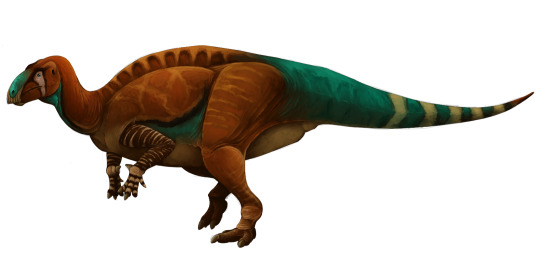
By Scott Reid
Ecosystem: Jinzhousaurus lived in the Yixian Formation, a highly diverse ecosystem showcasing the variety and evolution of birdie dinosaurs at the beginning of the Cretaceous period. This was a diverse coniferous forest in a temperate, seasonal climate. Very humid, it’s likely that Jinzhousaurus would have seen snow on a regular basis. There were notable dry seasons as well, leading to more tough vegetation for Jinzhousaurus to chew on. There were many flowering plants there too, along with ferns, horsetails, ginkgoes, cycads, seed ferns, and so many others - all good food for Jinzhousaurus. This was also a dense freshwater lake environment, with abundant minerals due to volcanic eruptions - leading to periodic environmental turnover.
Jinzhousaurus lived alongside many other kinds of dinosaurs, as this was an exceptionally diverse community. Here there was the ankylosaurid Liaoningosaurus, another ornithopod called Bolong, and an unnamed titanosaur in terms of other herbivores. There were many kinds of small fluffy dinosaurs - the Compsognathid Sinosauropteryx; the raptors Zhenyuanlong, Changyuraptor, Sinornithosaurus, and Tianyuraptor; the Troodontid Jianianhualong; the protobirds Jeholornis, Confuciusornis, and Zhongornis; the Anchiornithid Yixianosaurus; the Opposite Birds Dalingheornis and Shanweiniao; and the early nearly-true-birds Archaeorhynchus, Eogranivora, Yanornis, Hongshanornis, and Longicrusavis. Non-dinosaurs were of course also present - many types of fish, amphibians, and lizards; mammals such as Akidolestes, Sinobaatar, Sinodelphys, Chaoyangodens, and the famous Eomaia; Choristoderes like Hyphalosaurus and Monjurosuchus; and pterosaurs like Cathayopterus and Ningchengopterus. Essentially, a beautiful snapshot of the Early Cretaceous.
Other: Jinzhousaurus is sort of a mix between earlier ornithopods and the later hadrosaurs, so its classification was difficult to place for a while. But now it seems to be a basal member of the group that lead to the Hadrosaurids, rather than more close to Iguanodon proper.
~ By Meig Dickson
Sources under the Cut
Amiot, R., X. Wang, Z. Zhou, X. X. Wang, E. Buffetaut, C. Lécuyer, Z. Ding, F. Fluteau, T. Hibino, N. Kusuhashi, J. Mo, V. Suteethorn, Y. Y. Wang, X. Xu, F. Zhang. 2011. Oxygen isotopes of East Asian dinosaurs reveal exceptionally cold Early Cretaceous climates. Proceedings of the National Academy of Sciences 108 (13): 5179 - 5183.
Barrett, P. M., R. J. Butler, W. Xiao-Lin, X. Xing. 2009. Cranial anatomy of the Iguanodontoid Ornithopod Jinzhousaurus yangi from the Lower Cretaceous Yixian Formation of China. Acta Paleontologica Polonica 54(1): 35-48.
McDonald, A. T., D. G. Wolfe, J. I. Kirkland. 2010. A new basal hadrosauroid (Dinosauria: Ornithopoda) from the Turonian of New Mexico. Journal of Vertebrate Paleontology 30(3): 799-812.
Meng, F.X.; Gao, S.; Liu, X.M. (2008). "U-Pb zircon geochronology and geochemistry of volcanic rocks of the Yixian Formation in the Lingyuan area, western Liaoning, China". Geological Bulletin of China. 27: 364–373.
Wang, X., & X. Xu. 2001. A new iguanodontid (Jinzhousaurus yangi gen. et sp. nov.) from the Yixian Formation of western Liaoning, China. Chinese Science Bulletin 46(19): 1669-1672.
Wang, Y., S. Zheng, X. Yang, W. Zhang, Q. Ni. 2006. The biodiversity and palaeoclimate of confier floras from the Early Cretaceous deposits in western Liaoning, northeast China. International Symposium on Cretaceous Major Geological Events and Earth System: 56A.
Zhou, Z. 2006. Evolutionary radiation of the Jehol Biota: chronological and ecological perspectives. Geological Journal 41: 377-393.
#Jinzhousaurus#Jinzhousaurus yangi#Dinosaur#Ornithopod#Hadrosauroid#Palaeoblr#Cretaceous#Jehol Biota#Eurasia#Herbivore#Terrestrial Tuesday#Factfile#paleontology#prehistory#prehistoric life#dinosaurs#biology#a dinosaur a day#a-dinosaur-a-day#dinosaur of the day#dinosaur-of-the-day#science#nature
107 notes
·
View notes
Photo
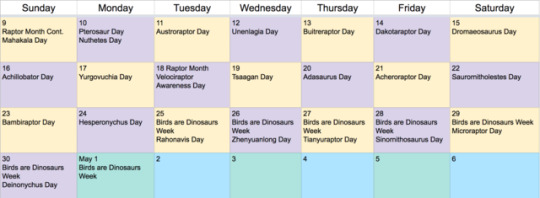
Here it is! The rest of Raptor Month!
As always, the 18th is Velociraptor Awareness Day, in which we remember what Velociraptor is actually like, rather than the media interpretation thereof
And the last week of April is Birds are Dinosaurs week, starting on the Birthday of the world’s Biggest BANDit (aka a scientist who clings to the disproven hypothesis that birds didn’t descend from dinosaurs), So what better than to talk about the dinosaurs that emphasized the bird-dinosaur link?!
We’ll start off with Mahakala on the 9th, the most early derived raptor known
Then we have Nuthetes on the 10th, which isn’t well known, but is from England, showing the European spread of this group!
Then we have Austroraptor on the 11th, the raptor that achieved gigantic size and isn’t shown enough love!
On the 12th we have Unenlagia day, another of the strange skinny raptor group, and the one that gave it it’s name!
On the 13th? Buitreraptor day, another Unenalgiian, a very smol one!
On the 14th we have Dakotaraptor day, because we can’t ignore a raptor that has captured the imaginations of many.
On the 15th, we have Dromaeosaurus day, and even though it’s not well known, we should pay attention to the one that gave it’s name to the whole shebang!
Next, on the 16th, is Achillobator day, the large raptor from Asia!
On the 17th it’s Yurgovuchia day, a smaller raptor known from Utah and closely related to big ones like Achillobator and Utahraptor!
On the 18th it’s VELOCIRAPTOR AWARENESS DAY, one of the biggest days in the ADADian calendar! I have no idea what I’ll be doing for it!
But Raptor Month surges on, and on the 19th It’s Tsaagan day, the raptor very similar than Velociraptor who deserves soooo much love.
On the 20th it’s Adasaurus day, the raptor from the Nemegt Formation!
We then go on to the 21st with Acheroraptor day, the OTHER raptor from Hell Creek!
On the 22nd it’s Saurornitholestes day, highlighting the most common small theropod from Dinosaur Provincial Park!
Then we have Bambiraptor on the 23rd, a raptor only described (though adults are known) from juvenile specimens!
Next we have Hesperornyhcus on the 24th, a Microraptorian from North America!
On the 25th we start Birds are Dinosaurs Week, and we start out with Rahonavis, an animal that has jumped around in classification between bird and raptor!
On the 26th we look at Zhenyuanlong, a Velociraptor-sized raptor with large wings preserved in its fossil!
Next up, on the 27th we have Tianyuraptor day, a raptor that may show a transition between the mainstream raptors and the strange forms in South America!
On the 28th we have Sinornithosaurus day, a raptor known with feather impressions in it’s fossil (and it wasn’t venomous, sorry gents)
On the 29th it’s Microraptor day, the day for the (first known) raptor with four wings!
And on the 30th it’s Deinonychus day, the day for the raptor who helped pave the way for understanding birds as dinosaurs!
And of course the entire week from the 25th to the 1st will also feature a lot of bird content for Birds are Dinosaurs Week!
Each day I’ll do a little shout out to the featured raptor, and I’ll reblog art tagged #RaptorMonth! I invite people to talk about raptors and share their thoughts about this excellent group of animals. Write stories, share hypotheses, talk about ontogeny, growth, behavior, all of it! There are so many exciting things to be done this month as we talk about raptors, birds, and everything in between.
Be sure to keep promoting the Utahraptor Block Project so we can keep raising funds throughout the month as we talk about all raptors! And be sure to use the hashtag #RaptorMonth!
#raptormonth#raptors#dinosaurs#birds#raptor month#utahraptorweek#utahraptor week#utahraptor#birds are dinosaurs#announcement#palaeoblr#birblr
166 notes
·
View notes
Note
So, do we have any idea exactly how agile Dromeosaurs were? I know just speed wise they are...average (faster than humans but less than most theropods, right?) but what about agility? Dodging, jumping, etc?
I don’t know of many studies testing this extensively (e.g.: quantitative estimation of turning radius, etc.), but it’s generally assumed that dromaeosaurids were quite agile, and this is supported by several aspects of their anatomy. For instance, their tails were stiffened for most of their length against vertical bending, which likely would have helped provide them with fine control of their leaping angle.
Dececchi et al. (2016) estimated the vertical and horizontal leaping abilities of a variety of Mesozoic coelurosaurs as part of their study. Out of their taxon sample, Zhenyuanlong was estimated as being capable of leaping the highest, around 0.6 m. In horizontal leaping, the dromaeosaurids they included (the largest of which was Tianyuraptor) were outdone by larger-bodied theropods (Sinocalliopteryx and Jianchangosaurus), but only by a small margin. Zhenyuanlong, Tianyuraptor, and (if assisted by flapping) Changyuraptor were all estimated as being capable of covering more than 1 m in horizontal distance.
Presumably using the same equations, Mike Habib has estimated that the largest dromaeosaurids such as Dakotaraptor (not included in the original study) may have been able to leap over 2 m off the ground and cover more than 12 m if leaping horizontally with a running start.
6 notes
·
View notes
Text
It’s Jehol Biota Day!
The Jehol Biota is the ecosystem of the Yixian and Jiofotang Formations of northeastern China, dating between 133 and 120 million years ago in the Early Cretaceous (from the Valanginian to Aptian ages).
It is famous because of it’s method of preservation - there were ash eruptions periodically, and the fossils are Lagerstätten, meaning that they were exceptionally well preserved with articulated skeletons, soft tissues, stomach contents, and even coloration.
This has led to an amazing understanding of various types of dinosaurs and other prehistoric animals, especially very birdy dinosaurs.
These animals lived in forests around lakes, dominated by conifers but featuring the earliest flowering plants - Archaefructus, which may have been a water plant.

By Shizhao, CC BY-SA 2.5
There were dry seasons, but it was a mostly wet formation, as many of the plants grew in very wet habitats and probably stayed close to bodies of water.
The Yixian Formation was the older of the two main Jehol Formations, and featured many, many animals. Of invertebrates, there were spiders, crustaceans, dragonflies, flies, wasps, many other insects, and molluscs, of too many to list. Fish included the lamprey Mesomyzon, ray finned fishes such as Lycoptera, Peipiaosteus, Protopsephurus, Sinamia, and Yanosteus, and a potential shark. There were frogs and toads like Callobatrachus, Liaobatrachus, and Mesophryne, as well as a salamander, Liaoxitriton.

Callobatrachus by Emily Willoughby, CC BY-SA 3.0
There were mammals, too, of course - the stem-placental Acristatherium, the stem-marsupials Akidolestes, Maotherium, Zhangheotherium, and Sinodelphys, the stem-therian (Therians being the group of Marsupials and Placentals) Eomaia, the multituberculate (a group of mammals which seem to also be stem-therians) Sinobaatar, and a significant number of Eutriconodonts, a group of early derived mammals, including Chaoyangodens, Gobiconodon, Jeholodens, Juchilestes, Meemannodon, Repenomamus, and Yanoconodon.
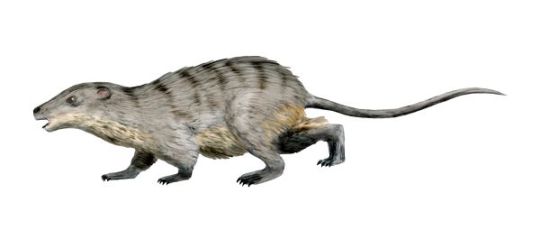
Eomaia by Nobu Tamura, CC BY-SA 3.0
There were the weird early derived Saurians (the group consisting of Lepidosauromorphs and Archosauromorphs, so Extant Reptiles), Choristoderans - Hyphalosaurus, which is known from thousands of specimens, and Monjurosuchus. Lizards included Dalinghosaurus, similar to the modern Chinese Crocodile Lizard; Liushusaurus and Yabeinosaurus, lizards relatedx to modern geckos and skinks, and Xianglong, a gliding lizard. Turtles included Manchurochelys and Ordosemys, both Cryptodirans, a group including giant tortoises, sea turtles, tortoises, snapping turtles, and others.

Hyphalosaurus by Matt Martyniuk, CC BY 3.0

Xianglong by Nobu Tamura, CC BY 3.0
The heroes of the formation were, of course, the Avemetatarsalians. There were many pterosaurs - Beipiaopterus, Boreopterus, Cathayopterus, Elanodactylus, Eosipterus, Feilongus, Gegepterus, Gladocephaloideus, Haopterus, Moganopterus, Ningchengopterus, Pterofiltrus, and Zhenyuanopterus.

Ningchengopterus by Nobu Tamura, CC BY 3.0
Ornithischians included the ornithopods Bolong, Jeholosaurus, and Jinzhousaurus, the ankylosaur Liaoningosaurus, and the ceratopsians Liaoceratops and Psittacosaurus. There were sauropods too - the titanosauriform Dongbeititan, a potential titanosaur, and an animal that has for now been referred to Euhelopus. But the real heavyweights were the theropods.

Jeholosaurus by @ryuukibart
There were the tyrannosauroids Yutyrannus - one of the best known tyrannosauroids with feathers - and Dilong; the compsognathus Huaxiagnathus, Sinocalliopteryx, and Sinosauropteryx - the first non-avian dinosaur known to have feathers, and also with known coloration; early Ornithomimosaurs such as Hexing and Shenzhousaurus; the early derived maniraptoran Yixianosaurus; Beipiaosaurus, a therizinosaur; and tons of Chickenparrots, such as Similicaudipteryx, Protarchaeopteryx, Ningyuansaurus, Incisivosaurus, and Caudipteryx.

Yutyrannus, model from “Dinosaurs Among Us”, photo by me
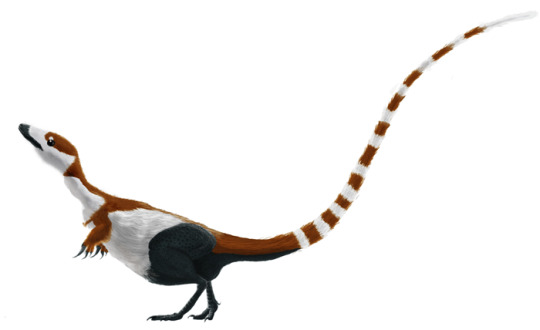
Sinosauropteryx by Matt Martyniuk, CC BY-SA 3.0
There were many Dromaeosaurids (raptors), such as Graciliraptor, Tianyuraptor, Zhenyuanlong - a raptor known from nearly complete feather traces, including extremely large wings - and Sinornithosaurus, the first Dromaeosaurid found with feathers. There were also lots of Troodontids, such as Sinusonasus, Sinovenator, and Mei, as well as unnamed members of both groups. There were early-derived Avialans such as Zhongornis, Jixiangornis, Confuciusornis, and Changchengornis. There were loads of Enantiornithines, such as Bohaiornis, Eoenantironis, Dalingheornis, Liaoningornis, Longirostravis, and Shanweiniao - an Enantiornithine that had a tail fan like modern birds. There were also Euornithines - the group which contains modern birds - such as Longicrusavis, Hongshanornis, and Archaeorhynchus. In short, this was an extremely birdy formation indeed.

Zhenyuanlong by Emily Willoughby, CC BY-SA 4.0
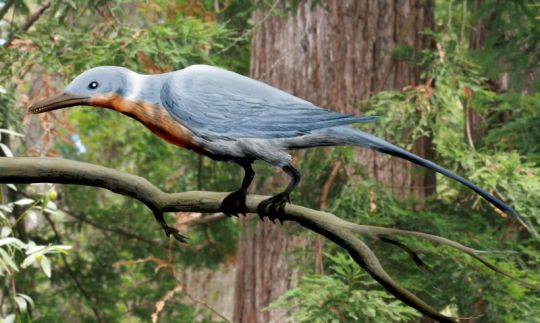
Shanweiniao by Nobu Tamura, CC BY 3.0
The Jiuofotang Formation was slightly younger, but was similar to the Yixian in terms of the animals there. There were ray finned fishes such as Jinanichthys, Lycoptera, Peipiaosteus, Protsephurus, and Sinamia. There was the mammal Liaoconodon, a Eutriconodont, as well as an unnamed mammal similar to Eomaia from the Yixian Formation. There were also Choristoderans like Philydrosaurus, Ikechosaurus, and Liaoxisaurus.

Liaoconodon by Dylan Bajda, CC BY-SA 4.0
There were many, many, many pterosaurs. This included Chaoyangopterus, Eoazhdarcho, Guidraco, Ikrandraco, Jidapterus, Liaoningopterus, Liaoxipterus, Linlongopterus, Nemicolopterus, Nurhachius, Shenzhoupterus, and Sinopterus. And, as we shall see, there were a lot of flying theropods as well, indicating that the two groups did live alongside one another just fine, and the common narrative of “birds replaced pterosaurs” has little foundation in the fossil record.
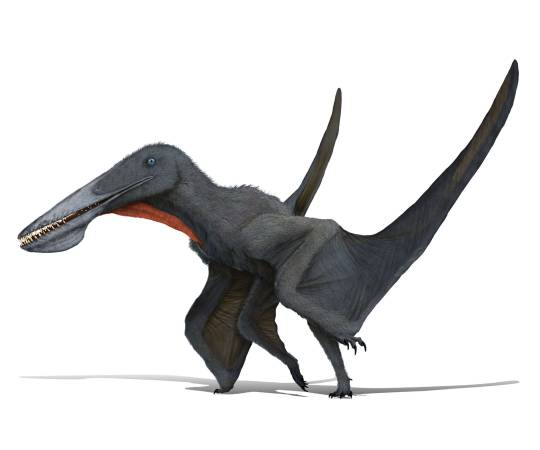
Ikrandraco, by Fabrizio De Rossi, from www.pteros.com

Chaoyangopterus, by Joschua Knüppe, from www.pteros.com
There were only a few Ornithischians - namely Chuanqilong, an ankylosaur, and Psittacosaurus, a ceratopsian. There is also an unnamed titanosaur from the formation. As for theropods, there were a lot. The tyrannosauroid Sinotyrannus was the largest predator there, there was the Chickenparrot Similicaudipteryx, and of course one of the most famous raptors, Microraptor, which was a four-winged Dromaeosaurid that we know had iridescent black feathers.
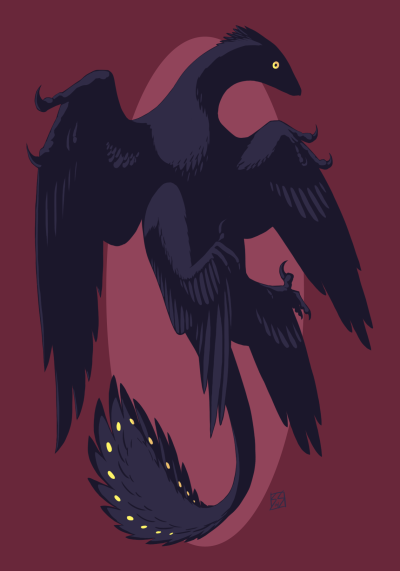
Microraptor by @artisticthingem
There were many early derived Avialans, such as Confuciusornis, Dalianraptor, Omnivoropteryx, Sapeornis, Shenshiornis, Zhongjianornis, and my personal favorite, Jeholornis, a theropod we know was a seed-eater, which is actually quite hard to determine from fossils. There were many Enantiornithines, such as Alethoalaornis, Boluochia, Cathayornis, Cuspirostrisornis, Dapingfangornis, Eocathayornis, Gracilornis, Huoshanornis, Largirostrornis, Longchengornis, Longipteryx, Rapaxavis, Xiangornis, and one of my favorites, Sinornis, which is thought to have perched. As for Euornithines, there was Chaoyangia, Jianchangornis, Parahongshanornis, Schizooura, Songlingornis, Yanornis, and Yixianornis.

Jeholornis by Matt Martyniuk, CC BY-SA 3.0
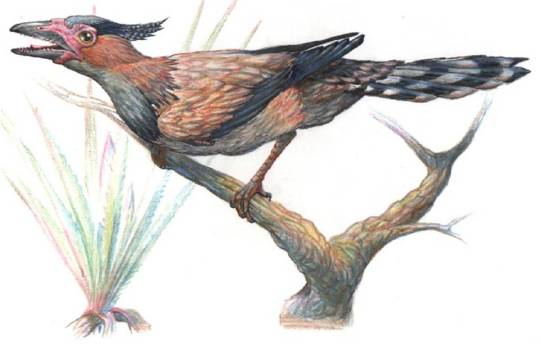
Sinornis, by Pavel Rhia, CC BY-SA 3.0
It’s plain to see why the Jehol Biota is so fascinating. At least for me, I love it because it’s clearly one of the best pictures we have of Pennaraptoran evolution - the amount of birdie dinosaurs is absolutely ridiculous. But there’s really something for everyone here - there are titanosaur-like things, some of the earliest Ceratopsians, tons of Pterosaurs, weird Choristoderans, and even some insights into the evolution of early mammals and different types of amphibians and fish, as well as the first flowering plants. The Jehol Biota is one of the best ecosystems we know about, and it definitely deserves celebration!
Sources:
https://en.wikipedia.org/wiki/Jehol_Biota
https://en.wikipedia.org/wiki/Jiufotang_Formation
https://en.wikipedia.org/wiki/Yixian_Formation
#dinosaurs#birds#pterosaurs#jehol biota#palaeoblr#prehistoric life#yixian formation#jiufotang formation
123 notes
·
View notes
Text
Tianyuraptor ostromi

By Ashley Patch on @apatchsketches
Name: Tianyuraptor ostromi
Name Meaning: Tianyu thief
First Described: 2010
Described By: Zheng et al.
Classification: Dinosauria, Saurischia, Eusaurischia, Theropoda, Neotheropoda, Averostra, Tetanurae, Orionides, Avetheropoda, Coelurosauria, Tyrannoraptora, Maniraptoriformes, Maniraptora, Pennaraptora, Paraves, Eumaniraptora, Dromaeosauroidea, Dromaeosauridae, Microraptoria
Tianyuraptor was another of our four-winged theropods, found in the Dawangzhangzi Bed, Yixian Formation, Liaoning, China. It lived from the Barremian to Aptian ages of the Early Cretaceous, about 122 million years ago. It was fairly unique in that it showed a variety of traits typically shown by both northern and southern types of dromaeosaurid from China. It was about 1.6 meters long, and had fairly short forelimbs compared to other dromaeosaurids, and had long hindlimbs like other microraptorines, though it was bigger than most microraptorines. Thus, it is typically described as a transitional form between dromaeosaurids like Microraptor and later ones like Velociraptor. It probably had a different lifestyle than other microraptors due to its short arms; it was not suited for gliding or flight and probably lived most of its life on the ground.
Sources:
http://en.wikipedia.org/wiki/Tianyuraptor
http://www.prehistoric-wildlife.com/species/t/tianyuraptor.html
Shout out goes to thehardcockkidshawnmichaels!
#tianyuraptor#tianyuraptor ostromi#thehardcockkidshawnmichaels#dinosaur#raptor#dinosaurs#a dinosaur a day#a-dinosaur-a-day#dinosaur of the day#dinosaur-of-the-day#science#nature#paleontology#biology#prehistory#prehistoric life#factfile
114 notes
·
View notes